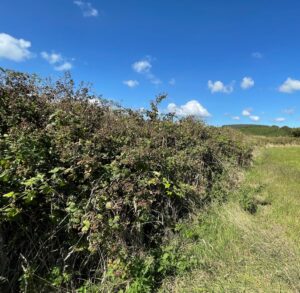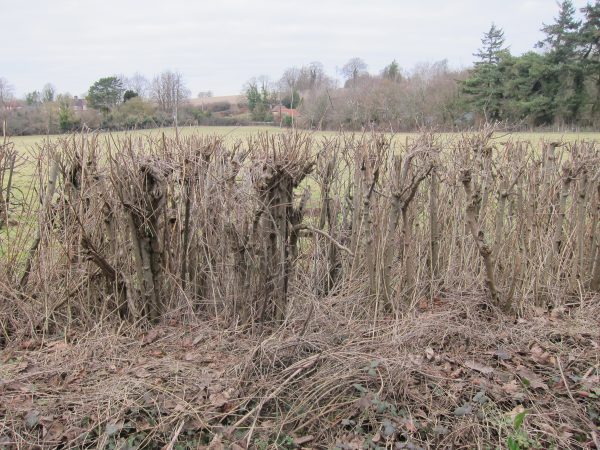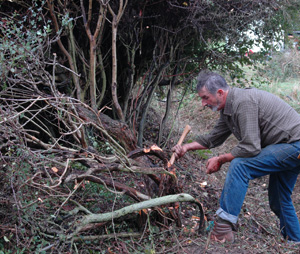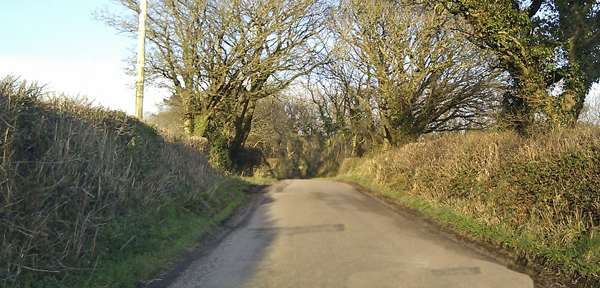Reaves, hedges and hedgerows

In parts of the South West, there is open moorland but some of its features betray its history. Running across the landscape there are faint lines. These lines are reaves, and they are a legacy of ancient farming and land management technique. They may run for many miles across the countryside. Reaves were essentially walls constructed from local stone and earth, and may date back to the Bronze Age. They were used to divide up the land for farming or grazing by livestock.
Instead of creating hedgerows, walls were built probably due to the availability of the stone [granite / slate] and the harsher climate back then. The reaves allow archaeologists some insight into the nature of ancient societies, their land use and agriculture. The area of Dartmoor and its environs offer a well preserved historic landscape {eg. The Great Western Reave) that has not been heavily ‘over-written’ by subsequent development.
In medieval times or later, hedgerows were planted along or near many of the reaves. Whilst reaves were not originally built to support hedges they sometimes became the base for hedgerows enclosing parcels of land. Some reaves align with more recent earth banks that are topped with shrubs of hazel and hawthorn. Many reaves have been gradually colonised over the years by various plants and animals. The structure / integrity of some reaves has been lost as their stones / slates were ‘redeployed’ to build new dry stone walls / boundaries in the 18th and 19th centuries.
Another type of boundary is the cornditch, This a bank with vertical stones on the side. Sometimes there is also an actual ditch - created where the soil was excavated to build the bank. Cornditches separated common grazing land [open moorland] from enclosed land / fields, essentially they stopped livestock entering cultivated areas. They may be seen around Exmoor and Dartmoor.
Reaves, hedgerows, hedges, banks all serve to separate up parcels of land, but they also add character to our countryside and serve to provide continuity across the landscape for many species (plant and animal) to move around.

Woodland bank with mature trees.
Many hedges have been lost due to the expansion of agriculture and increasing urbanisation, others have fallen into disrepair and some are flailed within an ’inch of their life’.

A flailed hedge
A sustainable way of managing tree lined hedge banks and a better alternative to the excessive cutting with heavy machinery is the traditional crafty of hedgelaying. This technique involves partially cutting stems of shrubs at a diagonal angle know as ‘pleaching’. Traditionally this would have been done with hand tools such as billhooks and axes with different regions of the Country having different designs of tool.
 Most species can be laid but most common are shrubs like hazel, hawthorn and blackthorn with some trees such as oak, beech or birch being allowed to grow on to become mature trees known as ‘standards’. Shrubs are laid by bending over and weaving them together holding with ‘stogs’ (see the woodlands blog on How to lay a hedge). Skilled workers declined in the later part of the 20th Century but is now on the rise again thanks to changes in land management aims and some grant funding being available. Ideally a hedge should be laid within 10 years of planting and should be and then can be regularly trimmed. After 50 years the hedge can be laid again. Some hedges, such as beech lined stone-faced hedges are not traditionally laid but trees are pollarded (cut to a height above where regrowth can be eaten by livestock or deer) on a rotation to prevent trees becoming too heavy and blowing over in the wind. This is also a good supply of timber for logs.
Most species can be laid but most common are shrubs like hazel, hawthorn and blackthorn with some trees such as oak, beech or birch being allowed to grow on to become mature trees known as ‘standards’. Shrubs are laid by bending over and weaving them together holding with ‘stogs’ (see the woodlands blog on How to lay a hedge). Skilled workers declined in the later part of the 20th Century but is now on the rise again thanks to changes in land management aims and some grant funding being available. Ideally a hedge should be laid within 10 years of planting and should be and then can be regularly trimmed. After 50 years the hedge can be laid again. Some hedges, such as beech lined stone-faced hedges are not traditionally laid but trees are pollarded (cut to a height above where regrowth can be eaten by livestock or deer) on a rotation to prevent trees becoming too heavy and blowing over in the wind. This is also a good supply of timber for logs.
Hedges act as biological corridors, and provide unique habitats / niches. Even dry stone walls offer opportunities for lichens and mosses, leading to the formation of biocrusts. Hedgerows are home to some 600 different plants, 1,500 insects, 65 birds and 20 mammal species – offering food and shelter, breeding and nesting sites. Many of these species have been identified as vulnerable. The loss of hedgerows, or a decline in their quality and care would effect the populations of these species. Hedgerows also serve to capture carbon, absorbing CO2 from the atmosphere which helps fight global warming by storing carbon in complex organic compounds. The roots of hedgerow shrubs and trees help reduce soil erosion, stabilising the soil and improving drainage, whilst the above ground stems and leaves reduce wind speed. In towns and cities, the leaves and aerial parts of hedges can ‘catch’ roadside pollutants and particulates.

Thanks to Stuart Brooking, who is the woodlands manager for Devon.
Comments are closed for this post.
Discussion
Nice!
Thank you

Thank you for spreading information about hedgerows. They remind me of my childhood lived mostly in rural Devon, Surrey, Hampshire, Berkshire and Wiltshire. I now live in Rutland and miss the trees and hedges. The landscape is much more open here with less wildlife.
Juliet Hawker
9 August, 2025